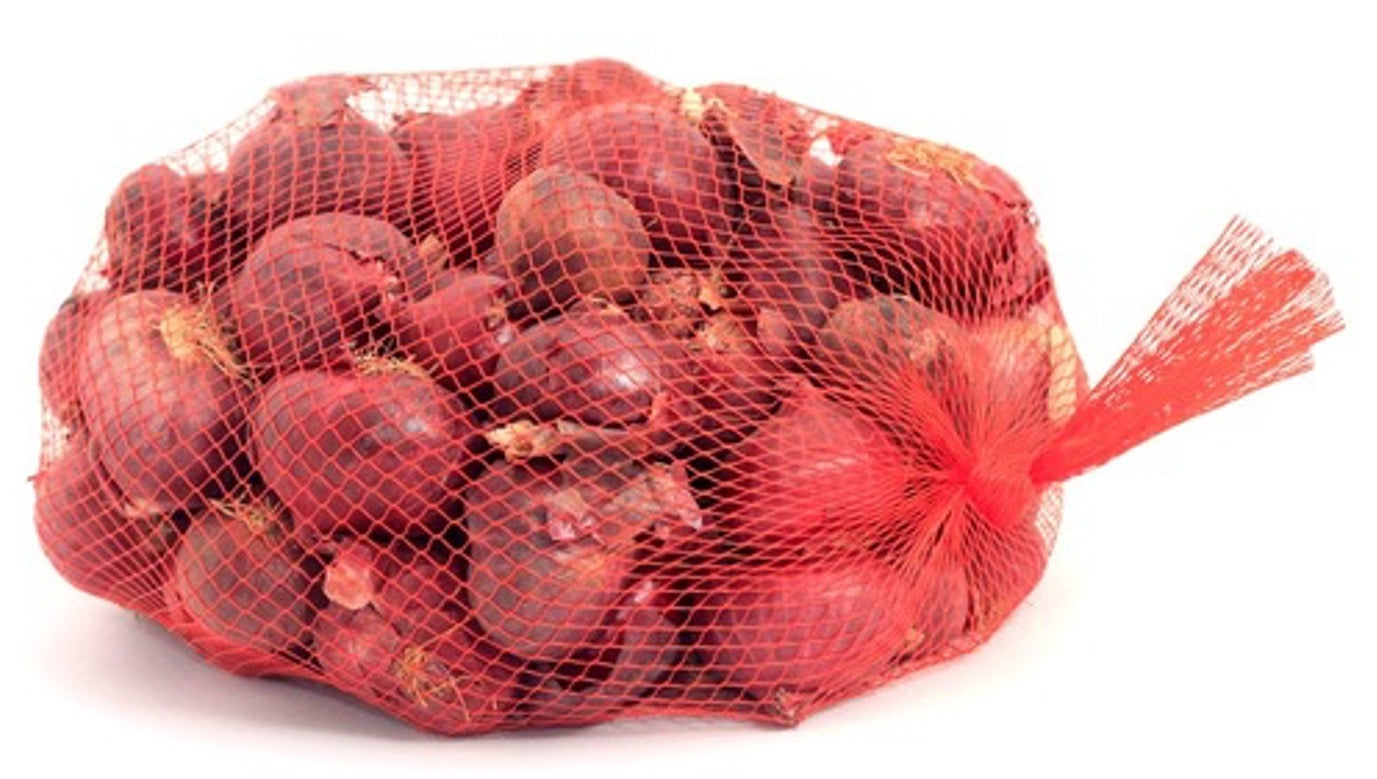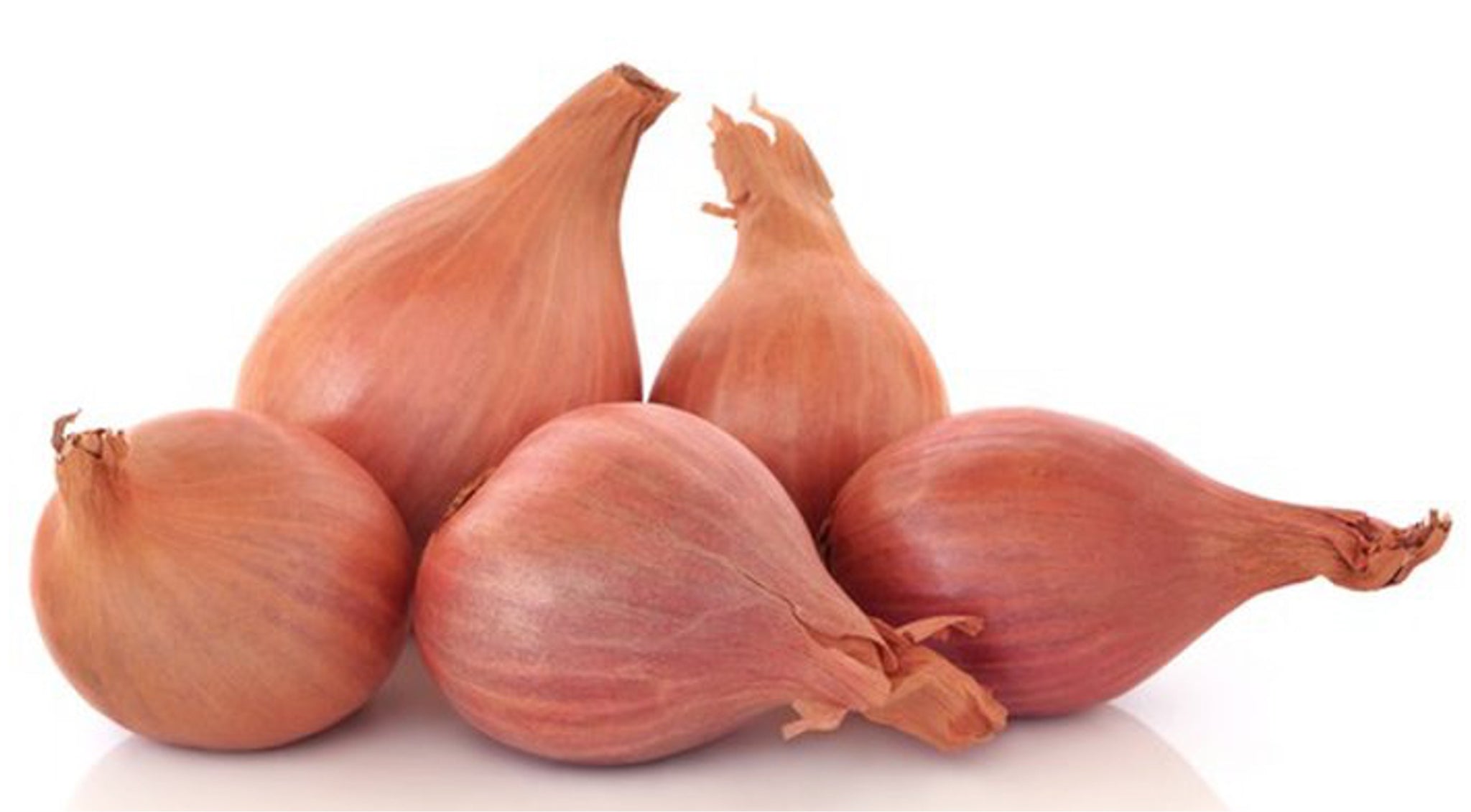Shallot Onions Bag
- Product Weight: 0 g
- Category: Fresh Fruits & Vegetables, Grocery & Gourmet Foods, Vegetables

Shallots are a small, elongated type of onion with a taste that’s often described as a subtle mix between a traditional onion and garlic.
They grow in clusters, contain less water, and have thinner peels than traditional onions but can make your eyes water just the same.
Loaded with nutrients and plant compounds, shallots offer numerous health benefits.
Still, you may wonder how these onions differ from other varieties and how to best use them in cooking.
This article reviews the benefits and uses of shallots, as well as how to substitute for shallots in recipes.
Shallots (Allium ascalonicum L.) belong to the Allium family, alongside leeks, chives, scallions, garlic, and other onion varieties, like Vidalia, white, yellow, and sweet onions.
Though they appear similar to red onions on the outside, they look very different on the inside. When you peel a shallot, you find that they have 3–6 cloves or bulbs — like garlic — instead of rings like other onions (1Trusted Source).
Nutritionally, they have quite a bit to offer, with 3.5 ounces (100 grams or about 10 tablespoons) of chopped shallots providing (2Trusted Source):
- Calories: 75
- Protein: 2.5 grams
- Fat: 0 grams
- Carbs: 17 grams
- Fiber: 3 grams
- Calcium: 3% of the Daily Value (DV)
- Iron: 7% of the DV
- Magnesium: 5% of the DV
- Phosphorus: 5% of the DV
- Potassium: 7% of the DV
- Zinc: 4% of the DV
- Folate: 9% of the DV
Compared with common onions, shallots are a more concentrated source of protein, fiber, and micronutrients, including calcium, iron, magnesium, phosphorus, potassium, zinc, copper, folate, B vitamins, and vitamins A and C (2Trusted Source).
What’s more, shallots and other vegetables in the Allium family are packed with powerful antioxidants and organosulfur compounds — all of which are responsible for many of their health benefits (3Trusted Source, 4Trusted Source, 5Trusted Source, 6Trusted Source).
One of these powerful compounds is allicin. It’s formed when shallots are crushed or cut, which releases their antioxidants (7Trusted Source).
SUMMARYShallots are a mild and highly nutritious variety of onion. They’re full of fiber, vitamins, minerals, antioxidants, and organosulfur compounds, all of which are responsible for many of their health benefits.
The organosulfur compounds and antioxidants in shallots are tied to most of their health benefits.
High in antioxidants
Antioxidants are compounds that help protect your cells from becoming damaged by substances called free radicals.
Too many free radicals can cause oxidative stress in your body, which can lead to inflammation, as well as chronic conditions like cancer, heart disease, and diabetes (8Trusted Source, 9Trusted Source, 10Trusted Source).
Shallots are rich in compounds with antioxidant activity, such as quercetin, kaempferol, and allicin.
One study analyzing the antioxidant activity of 11 popular varieties of onion found that shallots contained the highest amounts (11Trusted Source).
Another study compared the antioxidant strength of six Allium vegetables, noting that shallots had the second-highest strength after chives (12Trusted Source).
May relieve allergy symptoms
During an allergic reaction, cells in your body release histamine, which triggers symptoms like tissue swelling, watery eyes, and itchiness.
Shallots are high in quercetin, a plant flavonoid that may help reduce and manage eye and nose symptoms related to seasonal allergies (13Trusted Source).
Quercetin may act as a natural antihistamine by preventing the release of histamine and lessening the severity of inflammatory and respiratory reactions like allergic asthma, bronchitis, and seasonal allergies (14Trusted Source, 15Trusted Source).
In fact, it’s a primary ingredient in many seasonal allergy medications and supplements used to manage mild allergy symptoms that affect the eyes and nose (6Trusted Source).
Shallots are a small, elongated type of onion with a taste that’s often described as a subtle mix between a traditional onion and garlic.
They grow in clusters, contain less water, and have thinner peels than traditional onions but can make your eyes water just the same.
Loaded with nutrients and plant compounds, shallots offer numerous health benefits.
Still, you may wonder how these onions differ from other varieties and how to best use them in cooking.
This article reviews the benefits and uses of shallots, as well as how to substitute for shallots in recipes.
Shallots (Allium ascalonicum L.) belong to the Allium family, alongside leeks, chives, scallions, garlic, and other onion varieties, like Vidalia, white, yellow, and sweet onions.
Though they appear similar to red onions on the outside, they look very different on the inside. When you peel a shallot, you find that they have 3–6 cloves or bulbs — like garlic — instead of rings like other onions (1Trusted Source).
Nutritionally, they have quite a bit to offer, with 3.5 ounces (100 grams or about 10 tablespoons) of chopped shallots providing (2Trusted Source):
- Calories: 75
- Protein: 2.5 grams
- Fat: 0 grams
- Carbs: 17 grams
- Fiber: 3 grams
- Calcium: 3% of the Daily Value (DV)
- Iron: 7% of the DV
- Magnesium: 5% of the DV
- Phosphorus: 5% of the DV
- Potassium: 7% of the DV
- Zinc: 4% of the DV
- Folate: 9% of the DV
Compared with common onions, shallots are a more concentrated source of protein, fiber, and micronutrients, including calcium, iron, magnesium, phosphorus, potassium, zinc, copper, folate, B vitamins, and vitamins A and C (2Trusted Source).
What’s more, shallots and other vegetables in the Allium family are packed with powerful antioxidants and organosulfur compounds — all of which are responsible for many of their health benefits (3Trusted Source, 4Trusted Source, 5Trusted Source, 6Trusted Source).
One of these powerful compounds is allicin. It’s formed when shallots are crushed or cut, which releases their antioxidants (7Trusted Source).
SUMMARYHealth benefits of shallotsShallots are a mild and highly nutritious variety of onion. They’re full of fiber, vitamins, minerals, antioxidants, and organosulfur compounds, all of which are responsible for many of their health benefits.
The organosulfur compounds and antioxidants in shallots are tied to most of their health benefits.
High in antioxidants
Antioxidants are compounds that help protect your cells from becoming damaged by substances called free radicals.
Too many free radicals can cause oxidative stress in your body, which can lead to inflammation, as well as chronic conditions like cancer, heart disease, and diabetes (8Trusted Source, 9Trusted Source, 10Trusted Source).
Shallots are rich in compounds with antioxidant activity, such as quercetin, kaempferol, and allicin.
One study analyzing the antioxidant activity of 11 popular varieties of onion found that shallots contained the highest amounts (11Trusted Source).
Another study compared the antioxidant strength of six Allium vegetables, noting that shallots had the second-highest strength after chives (12Trusted Source).
May relieve allergy symptoms
During an allergic reaction, cells in your body release histamine, which triggers symptoms like tissue swelling, watery eyes, and itchiness.
Shallots are high in quercetin, a plant flavonoid that may help reduce and manage eye and nose symptoms related to seasonal allergies (13Trusted Source).
Quercetin may act as a natural antihistamine by preventing the release of histamine and lessening the severity of inflammatory and respiratory reactions like allergic asthma, bronchitis, and seasonal allergies (14Trusted Source, 15Trusted Source).
In fact, it’s a primary ingredient in many seasonal allergy medications and supplements used to manage mild allergy symptoms that affect the eyes and nose (6Trusted Source).
































